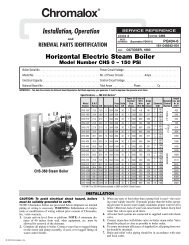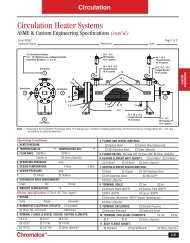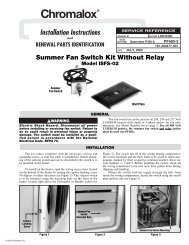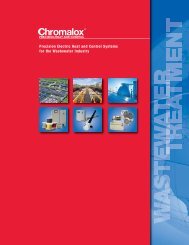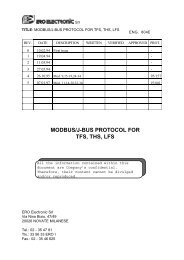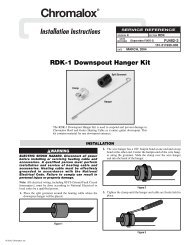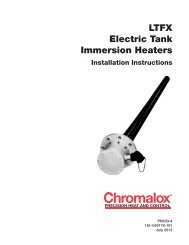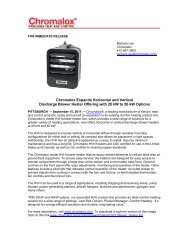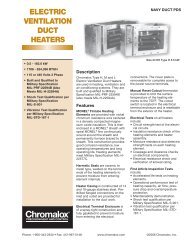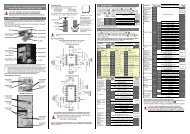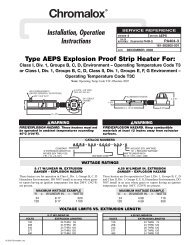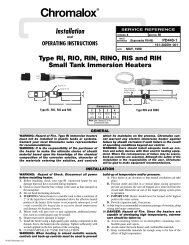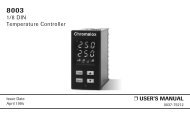TechnicalTechnical InformationHazardous Locations & Electric <strong>Heat</strong>er Applications (cont’d.)Class II — Dust 1 (NEC 500-3b)Groups E, F <strong>and</strong> G (Class II) — Combustibledusts are divided into Groups E, F <strong>and</strong> G.Classifi cation involves investigation <strong>and</strong> testingof the assembled enclosure including theclamped joints, clearances <strong>and</strong> shaft openings.The blanketing effect of layers of dust,the electrical conductivity <strong>and</strong> the ignitiontemperature of the dust are also evaluated.Group E Atmospheres contain metal dust,including aluminum, magnesium, their commercialalloys <strong>and</strong> other metals of similarlyhazardous characteristics having resistivityless than 10 5 Ohm-cm.Group F Atmospheres contain combustiblecarbonaceous dusts, charcoal, coal or otheratmospheres containing these dusts sensitizedby other hazardous materials <strong>and</strong> having resistivitygreater than 10 2 through 10 8 Ohm-cm.Group G Atmospheres contain combustibledusts such as fl our, grain, wood <strong>and</strong>chemicals having resistivity of 10 5 Ohm-cm,or greater.Class III — Fibers (NEC 500-7a) 1Atmospheres containing easily ignitable fi berssuch as rayon, cotton, fl ax, jute, hemp, kapok,excelsior <strong>and</strong> similar materials.Divisions in Hazardous LocationsThe NEC further sub-divides hazardous locationsinto Divisions (Div. 1 <strong>and</strong> 2). The requirementsfor Division 2 are less stringent than forDivision 1. The two divisions are discussed inthe following paragraphs.Division I LocationsClass I, Division 1 — NEC 500-5(a) is anarea where the hazard can exist under normaloperating conditions. Included are areas wherefl ammable or combustible liquids are transferredfrom one container to another, openvats, paint spray booths or any location whereignitable mixtures are used. Also included arelocations where a hazard is caused by frequentmaintenance, repair or equipment failure.Class II, Division 1 — NEC 500-6(a) is anarea where combustible dust is normally in theair in suffi cient quantities to produce ignitablemixtures or where mechanical failure orabnormal equipment operation might produceignitable mixtures. Locations also includeoperations where hazards exist because offrequent mechanical failure of machinery orequipment <strong>and</strong> where electrically conductivecombustible dusts (all Group E <strong>and</strong> someGroup F) are present in hazardous quantities.Class III, Division 1 — NEC 500-7(a) is anarea where easily ignitable fi bers or materialsproducing combustible fl yings are h<strong>and</strong>led,manufactured or used.Division 2 LocationsClass I, Division 2 — NEC 500-5(b) is an areawhere ignitable gases or vapors are h<strong>and</strong>led,processed or used, but which are normallyin closed containers or closed systems fromwhich they can only escape through accidentalrupture or breakdown of such containers orsystems.Class II, Division 2 — NEC 500-6(b) is anarea where combustible dust is not normallyin the air in suffi cient quantities to produceignitable mixtures or interfere with the operationof electrical equipment, or where dust ispresent as a result of infrequent malfunctioningof processing or h<strong>and</strong>ling equipment.Included are situations where combustibledust accumulations may interfere with the safedissipation of heat from electrical equipment.No electrically conductive dusts as defi nedin NEC 502-1, (last sentence) are included inClass II, Div. 2 atmospheres.Note — There is no Division 2 classifi cationfor Class II, Group E.Class III, Division 2 — NEC 500-7(b) is anarea where easily ignitable fi bers are stored orh<strong>and</strong>led.Class I — Adjacent DivisionsIn most indoor areas with adequate partitions,Div. 1 <strong>and</strong> 2 are self-contained areas. Withpartitions, a Div. 1 area may exist adjacent toa non-hazardous area. However, outdoors orin large indoor areas with few or no partitions,Class I, Div. 1 <strong>and</strong> Class 1, Div. 2 areasusually exist adjacent to each other. The Div. 1location being near the point of vapor release<strong>and</strong> Division 2 is at a given distance fromtherelease point of the fl ammable liquid. Wherethe spread of fl ammable vapors <strong>and</strong> gases isnot contained by adequate partitions, the areadesignated as Class I, Div. 2 serves as a “transitionzone” between the hazardous <strong>and</strong> nonhazardousarea. Div. 1 is the hazardous areawhere fl ammable gases or vapors are releasedfrom the liquid. Div. 2 is the area further awayfrom the point of release, where the gases orvapors are not normally of suffi cient concentrationto produce an ignitable mixture.Class I & II — Temperature RatingsOriginally, equipment in each group had onemaximum temperature rating. The maximumfor Groups A, B <strong>and</strong> D was 280°C (536°F) <strong>and</strong>Group C was 180°C (356°F). Recognizing thatchemicals <strong>and</strong> gases have different ignitiontemperatures, NEC revised the temperatureratings accordingly. <strong>Heat</strong> producing equipmentmust now be identifi ed by Class, Group, Division<strong>and</strong> “T” rating. The “T” rating shall notexceed the ignition temperature of the specifi cgas, vapor or dust present. Values for “T” ratingsfor Class I <strong>and</strong> II equipment are shown inthe table below:T-Ratings for Class I <strong>and</strong> IIMaximum Temperature Identifi cationDegrees (°C) Degrees (°F) “T” Number450 842 T1300 572 T2280 536 T2A260 500 T2B230 446 T2C215 419 T2D200 392 T3180 356 T3A165 329 T3B160 320 T3C135 275 T4120 248 T4A100 212 T585 185 T6Note 1 — For a complete list defi ning propertiesof fl ammable liquids, gases, solids ordusts, refer to the latest edition of NFPA 325,NFPA 497 or NFPA 499.TECHNICAL215
TechnicalTechnical InformationHazardous Locations & Electric <strong>Heat</strong>er Applications (cont’d.)CENELEC (& IEC) Zone Classifi cation SystemIntroduced to North America in 1996, the EuropeanCENELEC (<strong>and</strong> IEC) system of classifi -cation of hazardous locations is also permittedto apply to installations in the U.S. <strong>and</strong> Canadaas an alternative in Class I Locations, <strong>and</strong> isnow part of the NEC (Article 505) <strong>and</strong> CE Code(Section 18).Class I, Zone 0 - A location in which explosivegas atmospheres are present continuously orfor long periods of time.Class I, Zone 1 - A location in which explosivegas atmospheres are likely to exist in normaloperation or may exist frequently because ofrepairs, maintenance operations, <strong>and</strong> leakageor where equipment breakdowns could releasegases or vapors <strong>and</strong> also cause simultaneousfailure of electrical equipment in a mode tocause the electrical equipment to become asource of ignition.Class I, Zone 2 - A location in which explosivegas atmospheres are not likely to occur innormal operation <strong>and</strong>, if they do occur, willexist for a short time only; or where volatilefl ammable liquids, flammable gas, or fl ammablevapors are h<strong>and</strong>led, processed, orused, but are normally confi ned within closedcontainers or systems from which they canescape only as a result of accidental rupture orbreakdown of the containers or system, or as aresult of abnormal operation of the equipmentwith which the liquids or gases are h<strong>and</strong>led,processed, or used; or where ignitable concentrationsof fl ammable gases or vapors arenormally prevented by adequate ventilation,but which may occur as a result of failure orabnormal operation of the ventilation system.Class I GroupsGroup I - Atmospheres containing explosivegas in underground coal mines. Electricalapparatus that is intended for use in undergroundmines.Group IIC - Atmospheres containing acetylene,hydrogen (H2), or gases of equivalent hazard.Group IIB - Atmospheres containing acetaldehyde,ethylene, or gases or vapors ofequivalent hazard.Group IIA - Atmospheres containing acetone,ammonia, ethyl alcohol, gasoline, methane,propane, or gases or vapors of equivalenthazard. Note: There is potential for confusionbetween the NEC/CE <strong>and</strong> IEC gas classifi cationsystems since the Group letters are reversed216<strong>and</strong> even combined. Care should also be takento avoid confusing Group II <strong>and</strong> Class II, sinceboth use Roman numerals. An unintendedresult of specifying the IEC gas groups, whichcombine the traditional Groups A <strong>and</strong> B intoGroup IIC, is that equipment approved for hydrogen(H2) would also have to be approvedfor acetylene. Since very little equipment isdesigned for acetylene, the wording as originallyadopted severely limits the availabilityof equipment for hydrogen applications. As aresult, NEC Section 505-7(d) now allows forequipment to be listed for a specifi c gas orvapor, specifi c mixtures of gases or vapors, orany specifi c combination of gases or vapors.One common example is equipment markedfor “IIB + H2”. At present, the NEC or CE Codedoes not recognize any CENELEC or IEC dustclassifi cations.Combustion PrinciplesThree basic conditions must be satisfi ed fora fi re or explosion to occur. First, a fl ammableliquid, vapor or combustible dust mustbe present in suffi cient quantity. Second,the fl ammable liquid, vapor or combustibledust must be mixed with air or oxygen in theproportions required to produce an explosivemixture. Finally, a source of energy must beapplied to the explosive mixture.In applying these principles, the quantity ofthe fl ammable liquid or vapor that may beliberated <strong>and</strong> its physical characteristics mustbe recognized. Vapors from fl ammable liquidsalso have a natural tendency to disperse intothe atmosphere, <strong>and</strong> rapidly become dilutedto concentrations below the lower explosionlimit, particularly when there is natural ormechanical ventilation. In order to have anexplosive gas atmosphere, the concentrationof the gas or vapor must be above the LowerExplosive Limit (LEL) but below the UpperExplosive Limit (UEL). The possibility that thegas concentration may be above the upperexplosion limit does not afford any degree ofsafety, as the concentration must fi rst passthrough the explosive range to reach the upperexplosion limit.Equipment Marking RequirementsElectrical equipment permitted for use inhazardous locations must be marked to showthe Class, Division (or Zone under NEC Article505 <strong>and</strong> CE Section 18), Group, <strong>and</strong> maximumsurface operating temperature or temperaturecode referenced to a 40˚C (104˚F) ambienttemperature (some exceptions apply). Notethat the maximum external temperature of theequipment shall not exceed the minimum ignitiontemperature of the atmosphere that theequipment is located in.Electrical equipment approved for operation atambient temperatures exceeding 40˚C shall bemarked with the maximum ambient temperaturefor which the equipment is approved,<strong>and</strong> the operating temperature or temperaturerange at that ambient temperature.Equipment not marked to indicate a division,or marked “Division 1” or “Div. 1”, is suitablefor both Division 1 <strong>and</strong> 2 locations. Equipmentmarked “Division 2” or “Div. 2” is suitable forDivision 2 locations only. Equipment that islisted for a Zone 0 location shall be permittedin a Zone 1 or Zone 2 location of the same gasor vapor. Equipment that is listed for a Zone 1location shall be permitted in a Zone 2 locationof the same gas or vapor.Explosion-Proof EnclosuresMaximum Surface Temperature CodesMaximum Surface Identifi cation NumberTemperature NEC/CE IEC˚C (˚F) T-Code T-Code450˚ C (842˚F) T1 T1300˚ C (572˚F) T2 T2280˚ C (536˚F) T2A260˚ C (500˚F) T2B230˚ C (446˚F) T2C215˚ C (419˚F) T2D200˚ C (392˚F) T3 T3180˚ C (356˚F) T3A165˚ C (329˚F) T3B160˚ C (320˚F) T3C135˚ C (275˚F) T4 T4120˚ C (248˚F) T4A100˚ C (212˚F) T5 T585˚ C (185˚F) T6 T6An enclosure which will withst<strong>and</strong> an internalexplosion of a gas or vapor without rupture <strong>and</strong>without causing the ignition of an external gasor vapor.Explosion-proof enclosures are not water-proof.They are designed to contain <strong>and</strong> dissipateexplosions but they are not water-proof.To prevent the ignition of an external explosiveatmosphere, the enclosure must not only bestrong enough to withst<strong>and</strong> the internal explosionpressure, but all of the openings (e.g.,cover joints, conduit or cable entries, operatingshafts, etc.) must be tight enough to cool thehot burning gases before they can come intocontact with the external atmosphere.
- Page 1 and 2:
The Right Products and Solutionsfor
- Page 3 and 4:
Cold Weather ProductsCommercialWT W
- Page 5 and 6:
ivCold Weather Products
- Page 7 and 8:
LUHHorizontal Blower Heater (cont
- Page 9 and 10:
ComfortLUH Horizontal Blower Heater
- Page 11 and 12:
HVHHorizontal or VerticalDischarge
- Page 13 and 14:
ComfortHVH Horizontal or Vertical D
- Page 15 and 16:
ComfortHVH Horizontal or Vertical D
- Page 17 and 18:
ComfortKUHHorizontal Blower Heater
- Page 19 and 20:
ComfortKUHHorizontal BlowerHeater (
- Page 21 and 22:
ComfortUBHigh Capacity HorizontalBl
- Page 23 and 24:
ComfortUB High Capacity Horizontal
- Page 25 and 26:
ComfortVUHVertical DeliveryBlower H
- Page 27 and 28:
ComfortVUHDiffuser Selection & Heat
- Page 29 and 30:
ComfortHD3DHose Down CorrosionResis
- Page 31 and 32:
ComfortHD3DHose Down Corrosion Resi
- Page 33 and 34:
CXH-AExplosion Proof Blower Heaterf
- Page 35 and 36:
ComfortCXH-AExplosion ProofBlower H
- Page 37 and 38:
ComfortCXH-AExplosion ProofBlower H
- Page 39 and 40:
ComfortDRAPortable Spot IndustrialS
- Page 41 and 42:
ComfortDRAPortable Spot IndustrialS
- Page 43 and 44:
ComfortCCHCabinet ConsoleBlower Hea
- Page 45 and 46:
ComfortCCHCabinet ConsoleBlower Hea
- Page 47 and 48:
ComfortHCHWall MountedConvection He
- Page 49 and 50:
ComfortHCHWall MountedConvection He
- Page 51 and 52:
ComfortHHorizontalConvection Heater
- Page 53 and 54:
ComfortCPHHPump HouseConvection Hea
- Page 55 and 56:
ComfortCVEPConvection HeaterFor Haz
- Page 57 and 58:
ComfortCVEP Convection Heater For H
- Page 59 and 60:
ComfortCAF-6Architectural DraftBarr
- Page 61 and 62:
ComfortCCAS-8Architectural Slope To
- Page 63 and 64:
ComfortCCAS-12Architectural Slope T
- Page 65 and 66:
ComfortCAF-12ArchitecturalConvectio
- Page 67 and 68:
ComfortCAF-20Architectural CabinetC
- Page 69 and 70:
ComfortChromaStarInfra-RedRadiant H
- Page 71 and 72:
ComfortChromaStarInfra-RedRadiant H
- Page 73 and 74:
ComfortChromaStarAccessories(cont
- Page 75 and 76:
ComfortRBC-1Overhead RadiantSpace H
- Page 77 and 78:
ComfortRBC-3Fixed Overhead RadiantS
- Page 79 and 80:
ComfortUTUA-LT430” Dia.Round Cros
- Page 81 and 82:
ComfortKRSingle Fixed ElementRadian
- Page 83 and 84:
ControlsWR80-EPExplosion Proof Room
- Page 85 and 86:
ControlsWTLWall MountedResidential
- Page 87 and 88:
Heating CableSRLSelf-RegulatingLow
- Page 89 and 90:
SRLSelf-Regulating LowTemperature (
- Page 91 and 92:
Heating CableSRPSelf-RegulatingProc
- Page 93 and 94:
Heating CableSRM/ESelf-RegulatingMe
- Page 95 and 96:
SRM/ESelf-RegulatingMedium Temperat
- Page 97 and 98:
Heating CableCWMConstant Wattage Me
- Page 99 and 100:
Heating CableMIMineral InsulatedHig
- Page 101 and 102:
MIMineral InsulatedHigh Temperature
- Page 103 and 104:
Heating CableMIMineral Insulated Hi
- Page 105 and 106:
Heating CableHSRLSelf-RegulatingLow
- Page 107 and 108:
Heating CableHSRMSelf-RegulatingMed
- Page 109 and 110:
Heating CableHSRMSelf-RegulatingMed
- Page 111 and 112:
Heating CableSRFApplication & Selec
- Page 113 and 114:
Heating CableSRFSelf-Regulating Fre
- Page 115 and 116:
Heating CableSRF-RGSelf-RegulatingR
- Page 117 and 118:
Heating CableEdge-Cutter ®Roof De-
- Page 119 and 120:
ControlsAPS-4CAutomatic Snow/IceMel
- Page 121 and 122:
ControlsSC-40CSatellite Contactor
- Page 123 and 124:
ControlsGIT-3AGutter IceMelting Con
- Page 125 and 126:
ControlsCIT-1Snow Sensor• Reliabl
- Page 127 and 128:
ControlsSIT-6EPavement Sensor• Re
- Page 129 and 130:
Heating CableU SeriesHeat Trace Con
- Page 131 and 132:
Heating CableU SeriesHeat Trace Con
- Page 133 and 134:
Heating CableU SeriesHeat Trace Con
- Page 135 and 136:
Heating CableDL & EL SeriesConnecti
- Page 137 and 138:
DLIntegrated ConnectionAccessories
- Page 139 and 140:
Heating CableDLIntegrated Connectio
- Page 141 and 142:
Heating CableELStandard ConnectionA
- Page 143 and 144:
Heating CableHLHazardous LocationCo
- Page 145 and 146:
Heating CableB100 & E100Heat Trace/
- Page 147 and 148:
Heating CableRBFHeat Traceor Pipe S
- Page 149 and 150:
Heating CableDLIntegrated Temperatu
- Page 151 and 152:
Controls®HTLSHeat Tracing LineSens
- Page 153 and 154:
Controls®HTLSTwo, Three and Four-L
- Page 155 and 156:
Controls®HTLSThree-Loop Heat Traci
- Page 157 and 158:
Controls®HTLSC1D2Series C1D2Heat T
- Page 159 and 160:
Controls®HTLSHeat Tracing Line Sen
- Page 161 and 162:
ControlsHTLSHeat Tracing Line Sensi
- Page 163 and 164:
Controls®HTASHeat Tracing Ambient
- Page 165 and 166:
ControlsHTASHeat Tracing Ambient Se
- Page 167 and 168:
ControlsFreeze ProtectionHeat Trace
- Page 169 and 170: ControlsFreeze Protection Heat Trac
- Page 171 and 172: ControlsFreeze Protection Heat Trac
- Page 173 and 174: ControlsFreeze ProtectionHeat Trace
- Page 175 and 176: ControlsFreeze ProtectionHeat Trace
- Page 177 and 178: ComponentsPHD & PHDTHeavy Duty Fibe
- Page 179 and 180: SL-BSilicone Rubber InsulatedEnclos
- Page 181 and 182: ComponentsSLDHSilicone RubberInsula
- Page 183 and 184: TechnicalTechnical InformationDeter
- Page 185 and 186: Technical InformationGeneral Indust
- Page 187 and 188: 182TechnicalTechnical InformationTy
- Page 189 and 190: TechnicalTechnical InformationTypic
- Page 191 and 192: TechnicalTechnical InformationRadia
- Page 193 and 194: TechnicalTechnical Information90˚
- Page 195 and 196: TechnicalTechnical Information60˚
- Page 197 and 198: TechnicalTechnical Information60˚
- Page 199 and 200: TechnicalHeat Tracing ProductsIndus
- Page 201 and 202: Heat Tracing ProductsApplication &
- Page 203 and 204: Heat Tracing ProductsApplication &
- Page 205 and 206: TechnicalTechnical InformationDeter
- Page 207 and 208: TechnicalTechnical InformationElect
- Page 209 and 210: TechnicalTechnical InformationWirin
- Page 211 and 212: Reference Data206TechnicalPressure-
- Page 213 and 214: TechnicalReference DataPhysical & T
- Page 215 and 216: TechnicalReference DataEquivalents
- Page 217 and 218: TechnicalTechnical InformationNEMA
- Page 219: TechnicalTechnical InformationHazar
- Page 223 and 224: Technical Notes218
- Page 225 and 226: Cold Weather Technical ProductsInde




